[Español abajo]
We sat down with Mark Gonzalves, the creator of the new Children’s Play Area at Sonoma Garden Park to hear about his design process and his hopes for what this play area would bring to our beloved public park.
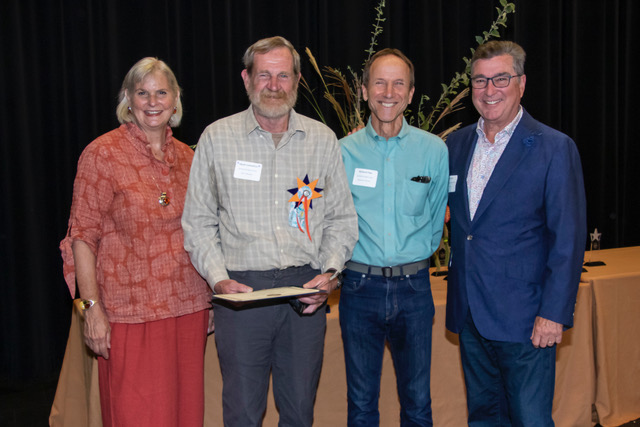
Mark Gonzalves (second from left) receiving the STAR Volunteer of the Year 2022 Award for his design and implementation of the Children’s Play Area at Sonoma Garden Park. Pictured above are, from left to right, Supervisor Susan Gorin, our Executive Director—Richard Dale, Mark Gonzalves, SEC Star Volunteer, and Dub Haye.
Can you tell us a little bit about your background? How did you come to design this play area?
I think volunteers are essential for a vibrant community. I have been volunteering in Sonoma Valley for many years. In fact, while in high school in the Peninsula, I volunteered at the then-Sonoma State hospital which prompted me to move to Glen Ellen. I have helped at the schools when my children were attending and spent many years on the Sonoma Soccer Board including being President.
I took the California Naturalist course from the Sonoma Ecology Center and one of my projects was building plant benches and a sign for the Sonoma Garden Park Nursery. That was my introduction to Sonoma Garden Park. Tony Passantino, the instructor, asked if I was interested in helping with the Children’s Play Area. As a landscape contractor for many years, I was thrilled to help out.
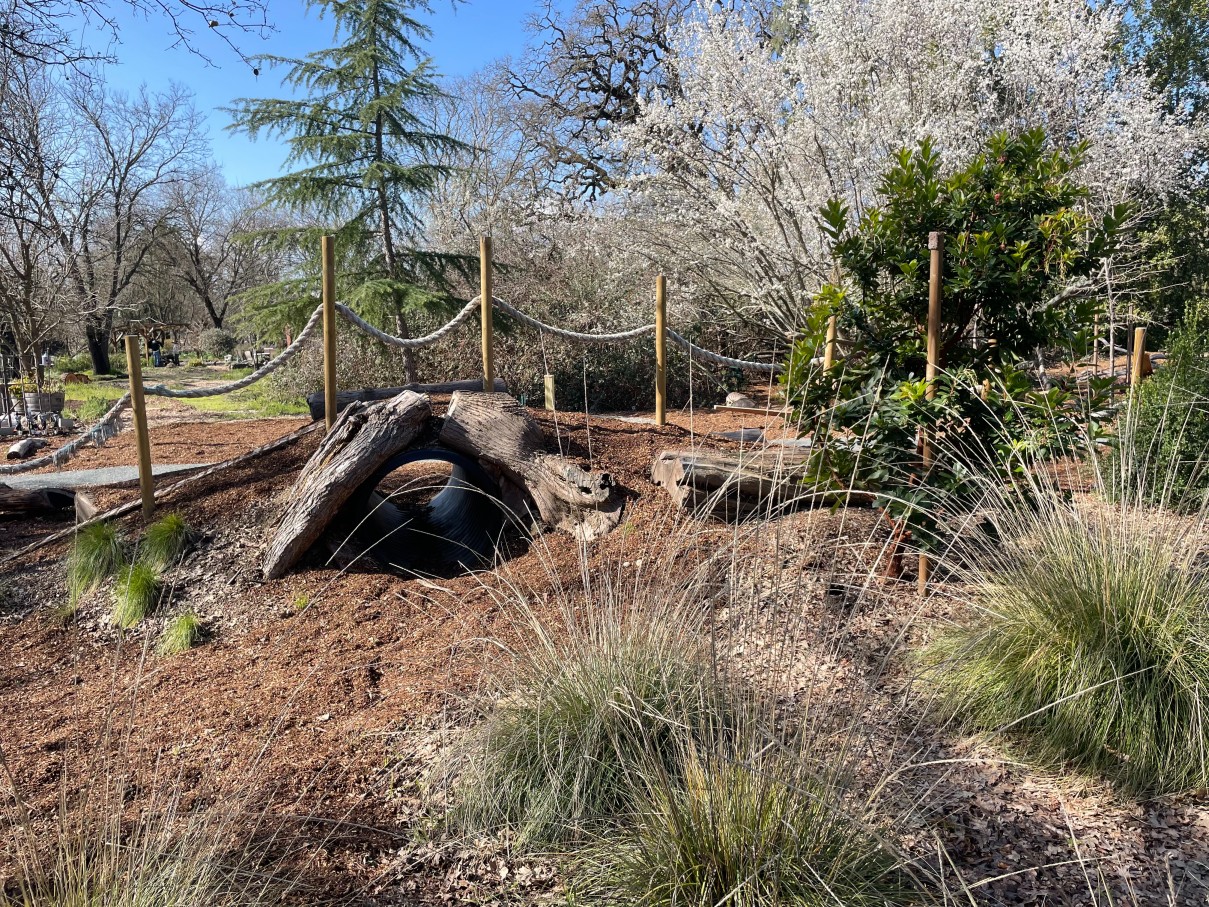
Mark reused logs and materials from another project to make the culvert for the tunnel at the Children’s Play Area. Above the culvert, the rope was brought from a tour to Alcatraz, where Mark and his wife asked if they could bring the un-used rope back to add to the Children’s Play Area.
What was your vision for the Children’s Play Area? Can you tell us a little bit about your design process?
In discussion with Tony, we wanted the Children’s Play Area to provide a place for kids to explore rather than having specific activities such as swings or slides. We also wanted to show the natural theme of the park.
For inspiration, we visited a wonderful preschool in Santa Rosa and got some ideas of what children liked in an outdoor setting and come up with specifics design ideas such as using gravel instead of sand for a play area, how to secure activity areas, and thoughts on the heights of tables and benches for kids. My initial drawing of the park encouraged one to meander through the area and find a place they enjoyed, maybe even out of sight of their parents!
We planted native plants: the Myrica californica (Pacific Wax myrtle) as a hedge to screen the neighbors from the new play area and two native oaks, Quercus agrifolia (Valley oak) and Quercus douglasii (Blue Oak) to provide shade to the area. We pruned a tunnel through the blackberry bushes and planted additional native shrubs and grasses to accent different areas and give some internal separation of the different play areas.
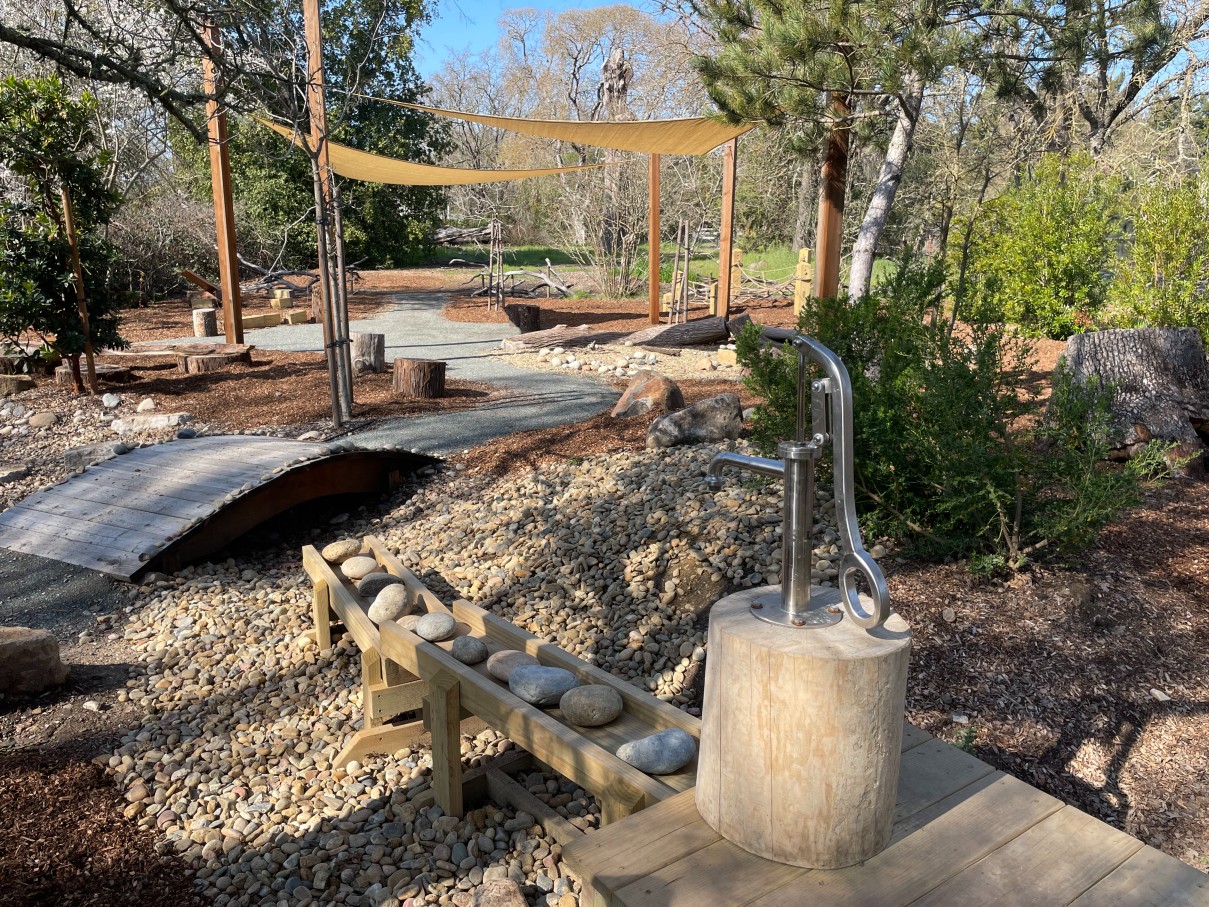
Many log structures, including the picnic table, kids table, and benches were made from wood of the Cypress tree that was cut at Sonoma Garden Park.
How did you choose to design and source materials for the play area? What was important for you in designing this project?
Reusing material was a big component. When we started the project, there was not much of a budget for materials. So through my work, I am always moving and re-using materials around from other projects. I used the wood from another project on fire prevention tree removal to build the now-fence near the picnic tables. We removed a deck to turn it into the bridge, and moved stones and boulders to create the beginning of the pond area.
I received redwood logs from a tree service and used materials from the Ghilotti construction yard to make the culvert for the tunnel. My favorite is the rope over the tunnel. While touring Alcatraz, my wife and I noticed a broken anchoring rope on the deck. After talking with the deckhand, who checked with the captain, I was informed that there was a rope waiting for me upon departure. I threw it over my shoulders, still wet, and took it to our car!
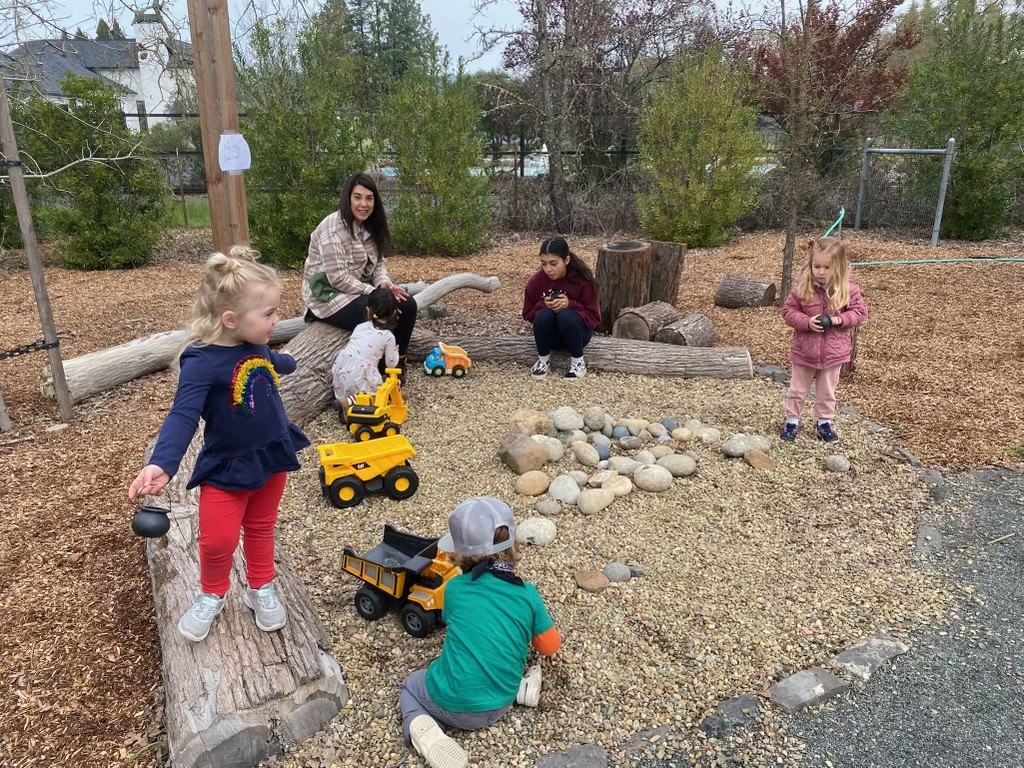
Children playing during a birthday party at the Children’s Play Area. Photo courtesy of Amanda Fleming.
Many of the log structures were made from limbs of the Cypress tree that was cut on site. The picnic table, kids table, and benches were made from logs of that same Cypress.
Once we received additional funding from the local donor, we were able to do much more. We brought in large trees and shrubs, over 40 yards of dirt for the mound, gravel for the pathways, and other assorted materials.
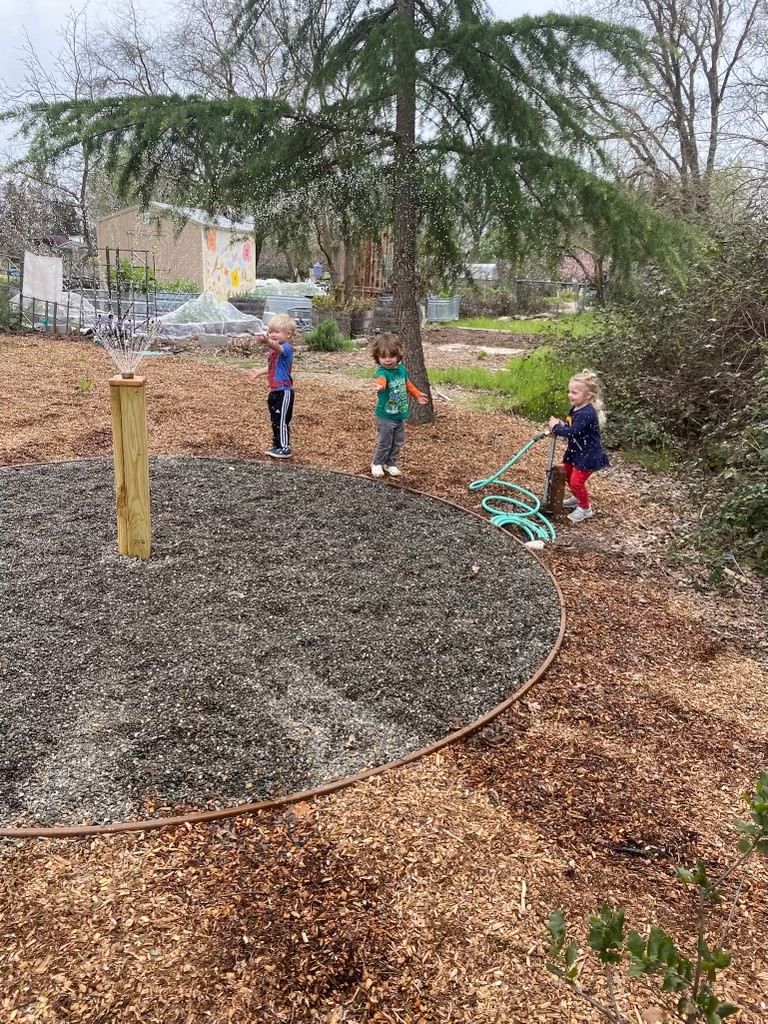

Children exploring features of the Children’s Play Area. Photo courtesy of Amanda Fleming.
What are you hoping this Children’s Play Area would bring to Sonoma Garden Park?
For parents to bring their children to the park! The park needed a specific area for younger kids. Since the Children’s Play Area has been completed, we have seen an increase in parents with younger children and even playgroups coming on a regular basis.

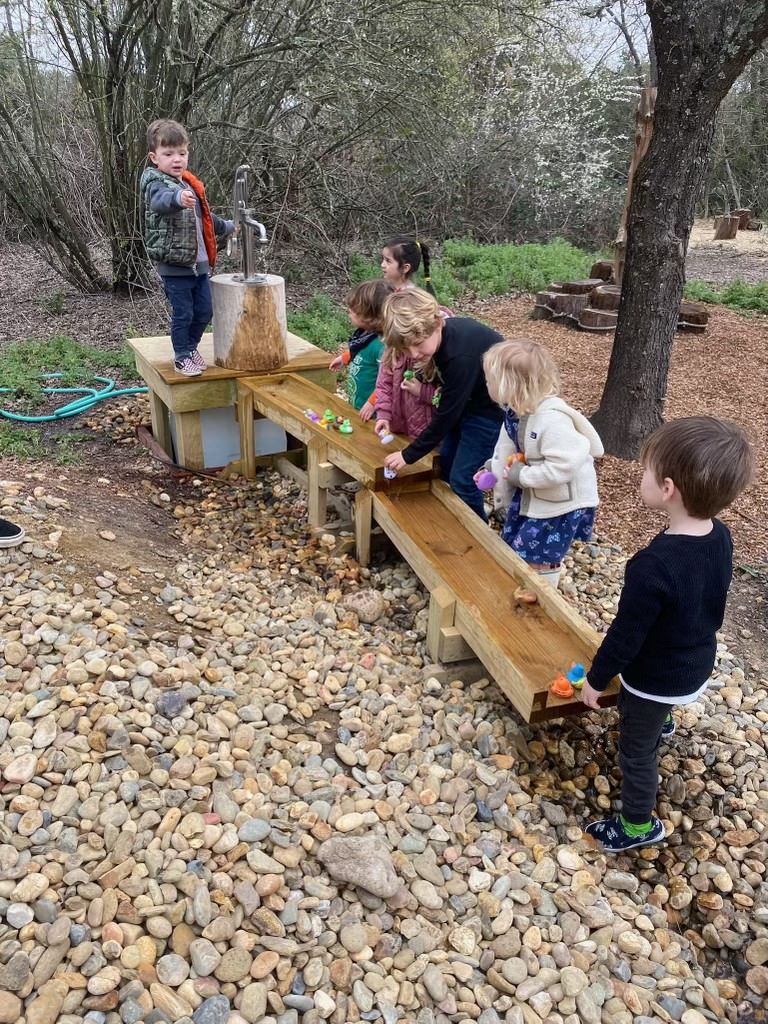
Children playing at the Children’s Play Area. The Play Area was built with the help of three Enviroleaders (paid interns of our sustainable agricultural vocational training program) under the supervision of Jonny Ehlers, SEC’s Education Project Manager). Photos courtesy of Amanda Fleming.
Is there anything else that you would like to share to the SEC community regarding your thoughts for the Children’s Play Area?
It was a pleasure to work with everyone who helped with the project. I had the chance to work with three Enviroleaders, under the supervision of Education Project Manager Jonny Ehlers, and taught them about planting, boulder placement, landscape design, and installation processes. It is fun to visit and see kids playing and moving around some of the scrap materials and even the small boulders to make the park their own.
I think we achieved our goal. The Children’s Play Area is inviting. Kids are exploring. And I must say it is beautiful!
Nos sentamos con Mark Gonzalves, el creador de la nueva área de juego en Sonoma Garden Park para aprender acerca de su proceso de diseño y lo que espera que esta área de juego traerá a nuestro querido parque público.

Mark Gonzalves (segunda persona a la izquierda) recibe el premio 2022 voluntario del año STAR por su diseño e implementación del área de juego en Sonoma Garden Park. En la foto, de izquierda a derecha, Supervisora Susan Gorin, nuestro Director ejecutivo—Richard Dale, Mark Gonzalves, Voluntario STAR de Sonoma Ecology Center, y Dub Haye.
¿Nos puedes contar acerca de tus antecedentes? ¿Cómo fué que te involucraste en diseñar esta área de juego?
Pienso que voluntarios son esenciales para una comunidad activa. He sido voluntario en el Valle de Sonoma por muchos años. De hecho, mientras estudiaba en la preparatoria en la Península [del Sur de la Bahía], me convertí en voluntario en lo que en esos días era el hospital Sonoma State, lo cuál me llevó a mudarme a Glen Ellen. He ayudado en las escuelas cuando mis niños atendían [escuelas] y serví años en la Mesa directiva de Sonoma Soccer, incluyendo como presidente.
Tomé el curso de California Naturalist ofrecido por Sonoma Ecology Center y uno de mis proyectos fué construir bancas con plantas y un letrero para el vivero de Sonoma Garden Park. Esa fué mi introducción a Sonoma Garden Park. Tony Passantino, el instructor, preguntó si estaba interesado en ayudar con el área de juego para niños. Como contractor paisajista por muchos años, estaba emocionado por ayudar.

Mark rehusó troncos y materiales provenientes de otros proyectos para hacer el túnel en el área de juego. Arriba del túnel, la cuerda fue traída de un paseo a Alcatraz, donde Mark y su esposa preguntaron si podían traer la cuerda que no había sido usada para añadirla al área de juego.
¿Cuál fue tu visión para el área de juego? ¿Nos puedes contar acerca de tu proceso de diseño?
En conversaciones con Tony, queríamos que el área de juego proveyera un lugar para que los niños exploren el lugar en vez de tener actividades específicas como columpios o resbaladillas. También queríamos resaltar el tema natural del parque.
Como inspiración, visitamos un maravilloso kinder en Santa Rosa donde obtuvimos algunas ideas de lo que a los niños les gusta en un espacio al aire libre y planeamos diseños específicos como el uso de grava en vez de arena para un área de juego, cómo sujetar las áreas de actividades, y recomendaciones en la altura de las mesas y bancas para niños. Mi dibujo inicial del parque invitaba a uno a pasear a través del área y encontrar un lugar para disfrutar, ¡inclusive tal vez fuera de la vista de sus padres!
Queríamos plantar plantas nativas: Morella californica (mirto de cera del Pacífico) como una cortina para los vecinos y dos robles nativos: Quercus agrifolia (roble del valle) and Quercus douglasii (roble azul) para sombrear el área. Cortamos un túnel a través de los arbustos de zarzamora y plantamos arbustos nativos y pastos para acentuar las diferentes áreas y darle separación interna a las diferentes áreas de juego.

Muchas de las estructuras de madera, incluyendo la mesa de picnic, la mesa de niños, y las bancas fueron construidas de la madera de un ciprés cortado en Sonoma Garden Park.
¿Cómo escogiste diseñar y buscar materiales para el área de juego? ¿Qué fue importante para tí al diseñar este proyecto?
Los materiales reusados fueron un gran componente. Cuando empezamos el proyecto, no había un presupuesto para materiales. A través de mi trabajo, siempre estoy moviendo y reusando materiales de otros proyectos. Usé la madera de otro proyecto enfocado en remover árboles para reducir el riesgo de incendios forestales] para construir la cerca junto a las mesas de picnic. Eliminamos una plataforma de madera y lo convertimos en un puente, y movimos las piedras y peñascos para crear el empiezo del estanque.
Recibí los troncos de sequoia roja de parte de un servicio de poda de árboles y usé materiales provenientes de la zona de construcción de Ghilotti para hacer la tubería de alcantarilla para el túnel. Mi [parte] favorita es el amarre naútico arriba del túnel. Mientras visitábamos Alcatraz, mi esposa y yo vimos un amarre roto en el muelle. Después de hablar con el marinero, quien consultó con el capitán, me informaron de que había un amarre esperándome antes de irnos. La cargué en mi hombro, aún mojada, ¡y la llevé a mi carro!

Niños juegan durante una fiesta de cumpleaños en el área de juego. Fotografía cortesía de Amanda Fleming.
Muchas de las estructuras de madera fueron hechas de ramas de un ciprés que estaba aquí y fué cortado. La mesa de picnic, la mesa de niños, y las bancas fueron construidas de ese mismo ciprés.
Cuando recibimos fondos adicionales de parte de un donador, pudimos hacer mucho más. Trajimos árboles grandes y arbustos, más de 40 yardas de tierra para el montículo de tierra, grava para los caminos, y otros materiales.


Niños exploran el área de juego. Fotografía cortesía de Amanda Fleming.
¿Que anhelas que esta área de juego traiga a Sonoma Garden Park?
¡Que padres traigan a sus niños al parque! El parque necesitaba un área dedicada a niños pequeños. Desde la compleción del área, hemos visto un incremento en padres con niños pequeños, e inclusive grupos de padres con niños pequeños visitando regularmente.


Niños jugando en el área de juego, construida con la ayuda de tres EnviroLeaders (pasantes renumerados de nuestro programa de entrenamiento vocacional en agricultura sostenible) bajo la supervisión de Jonny Ehlers, gerente de proyectos de educación con Sonoma Ecology Center). Fotografías cortesía de Amanda Fleming.
¿Hay algo que te gustaría compartir con la comunidad de Sonoma Ecology Center acerca de tus pensamientos para el área de juego?
Fue un placer trabajar con todos quienes ayudaron con este proyecto. Tuve la oportunidad de trabajar con tres EnviroLeaders bajo la supervisión del gerente de proyectos de educación Jonny Ehlers, y les enseñé acerca de plantar, cómo colocar peñascos, diseño de paisaje, y procesos de instalación. Fue divertido visitar y ver a niños jugando e interactuando con los materiales e inclusive moviendo algunos de los peñascos pequeños para realmente hacer la zona suya.
Pienso que logramos nuestro objetivo. El área de juego es acogedora. Niños están explorando. Y debo decir, ¡[el área] es bella!
